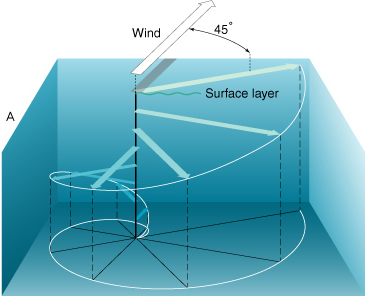

Once the wind sets surface waters in motion as a current, the Coriolis effect, Ekman transport, and the configuration of the ocean basin modify the speed and direction of the current. In this section, we consider the forces involved in the coupling of wind and ocean surface waters. Wind-driven Currents and Ekman Transport If Earth did not rotate, frictional coupling between moving air and the ocean surface would push a thin layer of water in the same direction as the wind. This surface layer in turn would drag the layer beneath it, putting it into motion. This interaction would propagate downward through successive ocean layers, like cards in a deck, each moving forward at a slower speed than the layer above. However, because Earth rotates, the shallow layer of surface water set in motion by the wind is deflected to the right of the wind direction in the Northern Hemisphere and to the left of the wind direction in the Southern Hemisphere. This deflection is known as the Coriolis effect. Except at the equator, where the Coriolis effect is zero, each layer of water put into motion by the layer above shifts direction because of Earth's rotation. 
The Ekman spiral describes how the horizontal wind sets surface waters in motion. As represented by horizontal vectors, the speed and direction of water motion change with increasing depth. Using vectors to plot the direction and speed of water layers at successive depths, we can show a simplified three-dimensional current pattern caused by a steady horizontal wind (Figure A). (A vector is an arrow representing a physical quantity so that length is directly proportional to magnitude and orientation represents direction.) This model is known as the Ekman spiral, named for the Swedish physicist V Walfrid Ekman (1874-1954) who first described it mathematically in 1905. Ekman based his model on observations made by the Norwegian explorer Fridtjof Nansen (1861-1930). Nansen was interested in ocean currents in polar seas. In 1893, he allowed his 39-m (128-ft) wooden ship, the Fram, to freeze into Arctic pack ice about 1100 km (680 mi) south of the North Pole. His goal was to drift with the ice and cross the North Pole thereby determining how ocean currents affect the movement of pack ice. The Fram remained locked in pack ice for 35 months but only came within 394 km (244 mi) of the North Pole. As the Fram slowly drifted with the ice, Nansen noticed that the direction of ice and ship movement was consistently 20 to 40 degrees to the right of the prevailing wind direction. |

Viewed from above in the Northern Hemisphere, the surface layer of water moves at 45 degrees to the right of the wind. The net transport of water through the entire wind-driven column (Ekman transport) is 90 degrees to the right of the wind. The Ekman spiral indicates that each moving layer is deflected to the right of the overlying layer's movement; hence, the direction of water movement changes with increasing depth. In an ideal case, a steady wind blowing across an ocean of unlimited depth and extent causes surface waters to move at an angle of 45 degrees to the right of the wind in the Northern Hemisphere (45 degrees to the left in the Southern Hemisphere). Each successive layer moves more toward the right and at a slower speed. At a depth of about 100 to 150 m (330 to 500 ft), the Ekman spiral has gone through less than half a turn. Yet water moves so slowly (about 4% of the surface current) in a direction opposite that of the wind that this depth is considered to be the lower limit of the wind's influence on ocean movement. In the Northern Hemisphere, the Ekman spiral predicts net water movement through a depth of about 100 to 150 m (330 to 500 ft) at 90 degrees to the wind direction (Figure B). That is, if one adds up all the vectors in (Figure A), the resulting flow is at 90 degrees to the right of the wind direction. In the Southern Hemisphere, the net water movement is 90 degrees to the left of the wind direction. This net transport of water due to coupling between wind and surface waters is known as Ekman transport. Because the real ocean does not match the idealized conditions of the Ekman spiral, wind-induced water movements often differ appreciably from theoretical predictions. In shallow water, for example, the water depth is insufficient for the full spiral to develop so that the angle between the horizontal wind direction and surface-water movements can be as little as 15 degrees. As waters deepen, the angle increases and approaches 45 degrees. The stable pycnocline inhibits the transfer of kinetic energy to deeper waters, helping to contain wind-driven currents to the mixed layer; that is, the pycnocline acts as a permeable boundary for Ekman transport and surface currents. Ekman transport piles up surface water in some areas of the ocean and removes water from other areas, producing variations in the height of the sea surface, causing it to slope gradually. One consequence of a sloping ocean surface is the generation of horizontal differences (gradients) in water pressure. These pressure gradients, in turn, give rise to geostrophic flow. Adapted from DataStreme Ocean and |